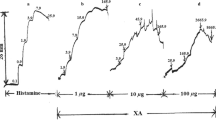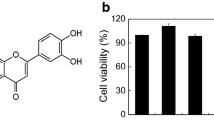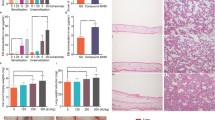Summary
In the present study, we demonstrated the inhibitory effect of magnolol on the plasma leakage in passive cutaneous anaphylactic (PCA) reaction, neurogenic inflammation, dorsal skin and ear edema in mice. Hind-paw skin plasma extravasation caused by antidromic stimulation of the saphenous nerve was reduced in mice pretreated with magnolol, diphenydramine or methysergide, but not with indomethacin. Ear edema formation in the PCA reaction was reduced by magnolol in dose-dependent manner. In addition, histamine-, serotonin-, compound 48/80-, bradykinin- and substance P-induced ear edema in mice was also suppressed by magnolol. A dose- and time-dependency of the inhibitory effect of magnolol was demonstrated in histamine- and compound 48/80-induced dorsal skin edema. The maximal inhibitory effect produced by a single dose of magnolol (10 mg/kg) persisted for 1 h, and significant suppression lasted for at least 3 h. In compound 48/80-pretreated mice, the histamine content of the ear was greatly reduced. Bradykinin- and substance P-induced ear edema in compound 48/80-pretreated mice was less severe than that seen in normal mice, but was still significantly reduced by magnolol pretreatment. Moreover, the inhibitory effect of magnolol was more marked than that of diphenhydramine combined with methysergide. These results suggest that the inhibitory effect of magnolol on local edema formation probably occurs through a nonselective inhibition on vascular tissue to prevent the permeability change caused by various mediators.
Similar content being viewed by others
References
Barrett AJ (1972) Lysosomes, In: Dingle JT (ed) A laboratory handbook. Elsevier, Amsterdam, pp 118–120
Dobbins DE, Soika CY, Premen AJ, Grega GJ, Dobney JM (1982) Blockade of histamine and bradykinin-induced increases in lymph flow, protein concentration and protein transport by terbutaline in vivo. Microcirc 2:127–150
Florjanc-Irman T, Erjavec F (1983) Compound 48/80 and substance P induced release of histamine and serotonin from rat peritoneal mast cells. Agents Actions 13:138–141
Foreman JC, Jordan CC (1984) Neurogenic inflammation. Trends Pharmacol Sci 5:116–119
Fujita M, Itokawa H, Sashida Y (1972) Honokiol, a new phenolic compound isolated from the bark of Magnolia obovata Thunb. Chem Pharm Bull 20:212–213
Gabbiani G, Badonnel MC, Majno G (1970) Intra-arterial injections of histamine, serotonin, or bradykinin: A tropographic sutdy of vascular leakage. Proc Soc Exp Biol NY 135:447–452
Gamse R, Holzer P, Lembeck F (1980) Decrease of substance P in primary afferent neurones and impairment of neurogenic plasma extravasation by capsaicin. Br J Pharmacol 68:207–213
Garrison JC (1991) Histamine, bradykinin, 5-hydroxytryptamine, and their antagonists. In: Gilman AG, Rall TW, Nies AS, Taylor P (eds) The pharmacological basis of therapeutics. Pergamon Press, New York, pp 575–599
Haddy FJ, Scott JB, Grega GJ (1976) Peripheral circulation: fluid transfer across the microvascular mechanism. In Guyton AG, Cowley AW, Jr (eds) Cardiovascular physiology II. Park Press, Baltimore, MD, pp 63–110
Håkanson R, Rönnberg AL (1974) Improved fluorometric assay of histamine. Anal Biochem 60:560–567
Hanahae THP (1984) Mechanism of histamine release from rat isolated peritoneal mast cells by dextran: the role of immunoglobulin E. Agents Actions 14:468–474
Heltianu C, Simionescu M, Simionescu N (1982) Histamine receptor of the microvascular endothelium revealed in situ with a histamine-ferritin conjugated: characteristic high-affinity binding sites in venules. J Cell Biol 93:357–364
Ialenti A, Ianaro A, Moncada S, Di Rosa M (1992) Modulation of acute inflammation by endogenous nitric oxide. Eur J Pharmacol 211:177–182
Insel PA (1990) Analgesic-antipyretic and antiinflammatory agents; drugs employed in the treatment of rheumatoid arthritis and gout. In: Gilman AG, Rall TW, Nies AS, Taylor P (eds) The pharmacological basis of therapeutics. Pergamon Press, New York, pp 638–681
Ito K, Iida T, Ichino K, Tsunezuka M, Mattori M, Namba T (1982) Obovatol and obovatal, novel biphenyl ether lignans from the leaves of Magnolia obovata Thunb. Chem Pharm Bull 30:3347–3353
Iwamoto I, Nadel JA (1989) Tachykinin receptor subtype that mediates the increase in vascular permeability in guinea pig skin. Life Sci 44:1089–1095
Jancsó N, Jancsó-Gabor A, Szolcsanyi J (1967) Direct evidence for neurogenic inflammation and its prevention by denervation and by pretreatment with capsaicin. Br J Pharmacol 31:138–151
Katayama S, Shionoya H, Ohtake S (1978) A new method for extraction of extravasated dye in the skin and the influence of fasting stress on passive cutaneous anaphylaxis in guinea pigs and rats. Microbiol Immunol 22:89–101
Lembeck F, Holzer P (1979) Substance P as neurogenic mediator of antidromic vasodilation and neurogenic plasma extravasation. Naunyn Schmiedebergs Arch Pharmacol 310:175–183
Lembeck F, Donnerer J, Barthó L (1982) Inhibition of neurogenic vasodilatation and plasma extravasation by substance P antagonists, somatostatin and [D-Met2, Pro5]enkephalinamide. Eur J Pharmacol 85:171–176
Lewis GP (1970) Kinins in inflammatory and tissue injury. Handb Exp Pharmak 25:516–530
Lewis T, Marvin HM (1927) Observations relating to vasodilatation arising from antidromic impulses, to herpes zoster and trophic effect. Heart 14:27–46
Majno G, Palade GE (1961) Studies on inflammation I. The effect of histamine and serotonin on vascular permeability. J Biophys Biochem Cytol 11:571–605
Maling HM, Webster ME, Williams MA, Saul W, Anderson W Jr (1974) Inflammation induced by histamine, serotonin, bradykinin and compound 48/80 in the rat: antagonists and mechanism of action. J Pharmacol Exp Ther 191:300–310
Marceau F, Knap M, Regoli D (1981) Pharmacological characterization of the vascular permeability enhancing effects of kinins in the rabbit skin. Can J Physiol Pharmacol 59:921–926
McClain DE, Donlon MA, Chock S, Catravas GN (1983) The effect of calmodulin on histamine release in the rat peritoneal mast cell. Biochem Biophys Acta 763:419–425
Moran NC, Uvnäs B, Westerholm B (1962) Release of 5-hydroxytryptamine and histamine from rat mast cells. Acta Physiol Scand 56:26–41
Morgan-Boyd R, Stewart JM, Vavrek RJ, Hassid A (1987) Effects of bradykinin and angiotensin II on intracellular Ca2+ dynamics in endothelial cells. Am J Physiol 253:C588-C598
Northover AM (1990) Modification by some antagonists of the shape changes of venous endothelial cells in response to inflammatory agents in vivo. Agents Actions 29:184–188
Owen DAA, Pipkin MA, Woodward DF (1984) Studies on cutaneous vascular permeability in the rat: increases caused by histamine and histamine-like agents. Agents Actions 14:39–42
Paton WDM (1951) Compound 48/80, a potent histamine liberator. Br J Pharmacol 6:499–508
Perper RJ, Qronsky AL, Blamcuzzi U (1975) An analysis of the specificity in pharmacological inhibition of the passive cutaneous anaphylaxis reaction in mice and rats. J Pharmacol Exp Ther 193:594–602
Saria A, Lundberg JM, Skofitsch G, Lembeck F (1983) Vascular protein leakage in various tissues induced by substance P, capsaicin, bradykinin, serotonin, histamine and by antigen challenge. Naunyn Schmiedebergs Arch Pharmacol 324:212–218
Saria S, Hua X, Skofitsch G, Lundberg JM (1984) Inhibition of compound 48/80-induced vascular protein leakage by pretreatment with capsaicin and a substance P antagonist. Naunyn Schmiedebergs Arch Pharmacol 328:9–15
Shore PA, Burkhalter A, Cohen VH Jr (1959) A method for the fluorometric assay of histamine in tissue. J Pharmacol Exp Ther 127:182–186
Sjoerdsma A, Wualkes TP, Weissbach H (1957) Serotonin and histamine in mast cells. Science 125:1202–1203
Sullivan TJ, Parker CW (1979) Possible role of arachidonic acid and its metabolites in mediator release from rat mast cells. J Immunol 122:431–436
Svensjo E, Persson CGA, Rutili G (1977) Inhibition of bradykinin induced macromolecular leakage from post-capillary venules by a β2-adrenoceptor stimulant, terbutaline. Acta Physiol Scand 101: 504–506
Svensjo E, Sharp D, Arfors KE (1973) Leakage induced by histamine in postcapillary venules on the hamster check pouch. Microvasc Res 6:261
Taira M, Kohno SW, Yamamura H, Ohata K (1988) Lack of involvement of leukotriene and platelet activating factor in passive cutaneous anaphylaxis in rats. Agents Actions 24:189–195
Teng CM, Chen CC, Ko FN, Lee LG, Huang TF, Chen VP, Hsu HY (1988) Two antiplatelet agents from Magnolia officinalis. Thromb Res 50:757–765
Teng CM, Yu SM, Chen CC, Huang YL, Huang TF (1990) EDRF-release and Ca++-channel blockade by magnolol, an antiplatelet agent isolated from Chinese herb Magnolia officinalis, in rat thoracic aorta. Life Sci 47:1153–1161
Teng CM, Ko FN, Wang JP, Lin CN, Wu TS, Chen CC, Huang TF (1991) Antihaemostatic and antithrombotic effect of some antiplatelet agents isolated from Chinese herbs. J Pharm Pharmacol 43:667–669
Tsurufuji S, Sugio K, Takemasa F (1979) The role of glucocorticoid receptor and gene expression in the anti-inflammatory action of dexamethasone. Nature 280:408–410
Wang JP, Hsu MF, Ouyang C, Teng CM (1989) Edematous response caused by [Thi5,8, D-Phe7] bradykinin, a B2 receptor antagonist, is due to mast cell degranulation. Eur J Pharmacol 161:143–149
Wang JP, Hsu MF, Raung SL, Chen CC, Kuo JS, Teng CM (1992) Antiinflammatory and analgesic effects of magnolol. Naunyn Schmiedebergs Arch Pharmacol 346:707–712
Watanabe K, Watanabe H, Goto Y, Yamamoto N, Yoshizaki M (1975) Studies on the active principles of magnolia bark: centrally acting muscle relaxant activity of magnolol and honokiol. Jpn J Pharmacol 25:605–607
Waynforth HB (1980) Specific surgical operations. In: Waynforth HB (ed) Experimental and surgical technique in the rat. Acedemic Press, London, pp 124–208
Author information
Authors and Affiliations
Additional information
Correspondence to: J.-P. Wang at the above address
Rights and permissions
About this article
Cite this article
Wang, JP., Raung, SL., Chen, CC. et al. The inhibitory effect of magnolol on cutaneous permeability in mice is probably mediated by a nonselective vascular hyporeactivity to mediators. Naunyn-Schmiedeberg's Arch Pharmacol 348, 663–669 (1993). https://doi.org/10.1007/BF00167245
Received:
Accepted:
Issue Date:
DOI: https://doi.org/10.1007/BF00167245




